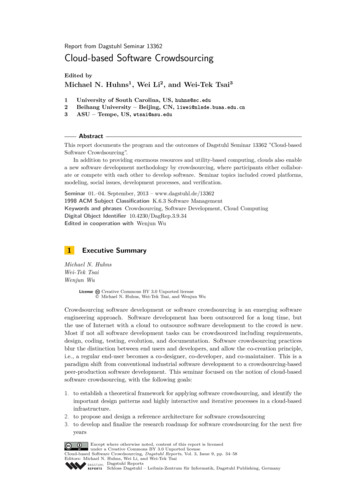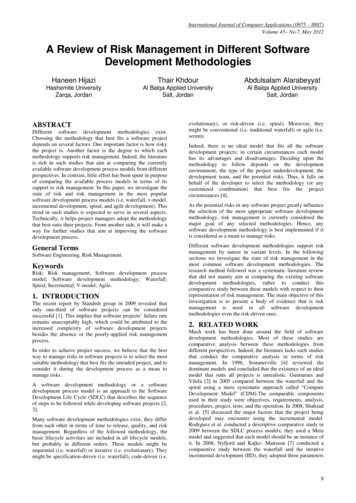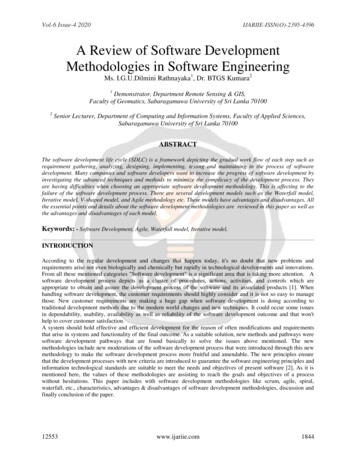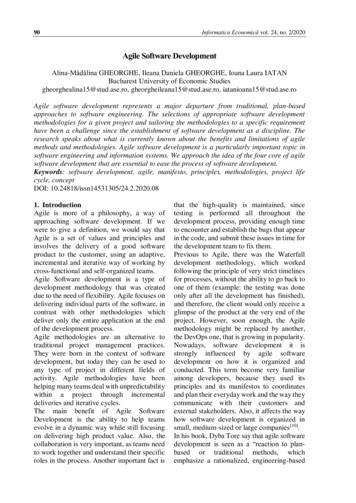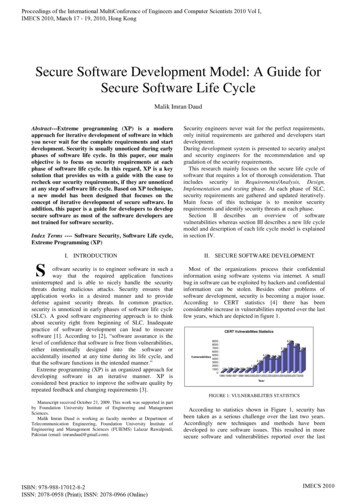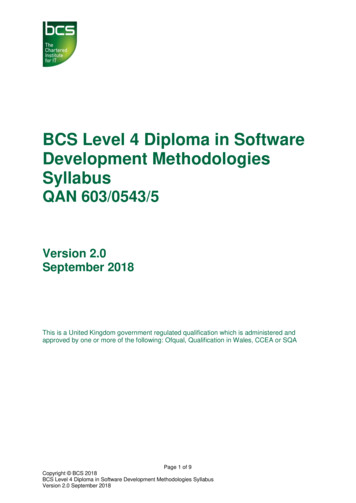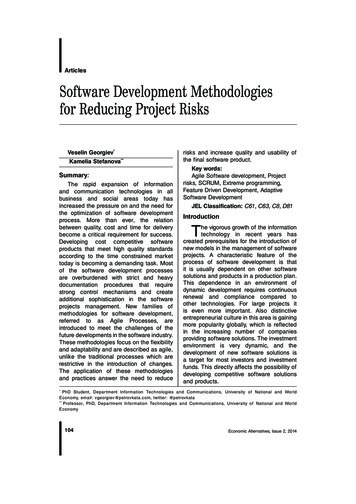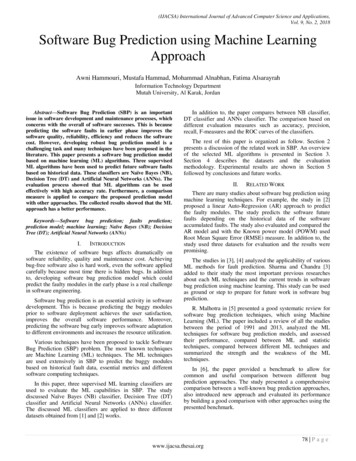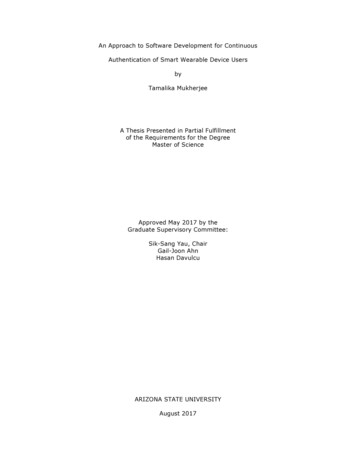
Transcription
An Approach to Software Development for ContinuousAuthentication of Smart Wearable Device UsersbyTamalika MukherjeeA Thesis Presented in Partial Fulfillmentof the Requirements for the DegreeMaster of ScienceApproved May 2017 by theGraduate Supervisory Committee:Sik-Sang Yau, ChairGail-Joon AhnHasan DavulcuARIZONA STATE UNIVERSITYAugust 2017
ABSTRACTWith the recent expansion in the use of wearable technology, a large numberof users access personal data with these smart devices. The consumer market ofwearables includes smartwatches, health and fitness bands, and gesture controlarmbands. These smart devices enable users to communicate with each other, controlother devices, relax and work out more effectively. As part of their functionality, thesedevices store, transmit, and/or process sensitive user personal data, perhaps biologicaland location data, making them an abundant source of confidential user information.Thus, prevention of unauthorized access to wearables is necessary. In fact, it isimportant to effectively authenticate users to prevent intentional misuse or alterationof individual data. Current authentication methods for the legitimate users of smartwearable devices utilize passcodes, and graphical pattern based locks. These methodshave the following problems: (1) passcodes can be stolen or copied, (2) they dependon conscious user inputs, which can be undesirable to a user, (3) they authenticatethe user only at the beginning of the usage session, and (4) they do not consider userbehavior or they do not adapt to evolving user behavior.In this thesis, an approach is presented for developing software for continuousauthentication of the legitimate user of a smart wearable device. With this approach,the legitimate user of a smart wearable device can be authenticated based on theuser's behavioral biometrics in the form of motion gestures extracted from theembedded sensors of the smart wearable device. The continuous authentication of thisapproach is accomplished by adapting the authentication to user's gesture patternchanges. This approach is demonstrated by using two comprehensive datasetsgenerated by two research groups, and it is shown that this approach achieves betterperformance than existing methods.i
Index terms: continuous user authentication; smart wearable devices;behavioral biometrics; adaptive authentication.ii
DEDICATIONThis thesis is dedicated to my parents.It would not have been possible without you two!iii
ACKNOWLEDGMENTSFirst, I would like to express my sincere gratitude to my adviser ProfessorStephen S. Yau for letting me be a part of his research laboratory. I am thankful forhis support, patience, motivation and for the immense knowledge that he shared withme. His guidance helped me a lot and I learned a lot from him.Besides my adviser, I would like to thank Professors Gail-Joon Ahn and HasanDavulcu for their insightful comments, and suggestions on my thesis and for takingthe time to be members of my Supervisory Committee.I also want to thank my laboratory mates Dr. Arun Balaji Buduru, Mr. YaozhongSong, and Mr. Vineet Mishra for their valuable inputs.Last but not the least; I would like to thank my dear friends Himanshu Waidya,Aditya Bivalkar, Aditya Dabak and Kedar Pitke for their constant encouragement, andsupport.iv
TABLE OF CONTENTSPageLIST OF TABLES . viLIST OF FIGURES . viiCHAPTER1INTRODUCTION . . 11.1Overview . 11.2Organization of Thesis . 62CURRENT STATE OF THE ART . 83THE OVERALL APPROACH TO SECURE SMART WEARABLES . 183.1Threat Model of Our Approach . 183.2Assumptions . 183.3Our Overall Approach . 204DATA COLLECTION . . 255FEATURE EXTRACTION . . 286TRAINING THE GRADIENT BOOSTED TREE MODEL OF OUR APPROACH . 3276.1Background . 326.2Decision Trees . 336.3Feature Selection . 356.4Gradient Boosting . 396.5Regularization . 446.6Reducing Bias . 476.7Cross Validation. 486.8Tree Model Evaluation . 49AUTHENTICATION . . 53v
CHAPTERPage8ADAPTATION . . 559CASE STUDY OF OUR APPROACH . 589.1Data Collection . 589.2Feature Extraction . 599.3Data Preparation for Training the Tree Model. 599.4Feature Selection and Training the Tree Model. 619.5Tree-Model Evaluation . 629.6Results . 629.7Comparison . 649.8Adaptation . 669.9Running Our Approach as a Service . 689.10 Discussion . 6810CONCLUSION AND FUTURE WORK . 71REFERENCES. . 73vi
LIST OF TABLESTablePage1.Popular Smart Devices with Accelerometer and Gyroscope Sensors . 262.Data Collection . 273.Extracted Features . 314.Evaluation Results . 635.Comparison with Existing Methods . 656.Stratified Sampling as a means of Data Sampling . 67vii
LIST OF FIGURESFigurePage1.Popular Smart Wearable Devices . 22.Myo Gesture Control Armband . 43.Passcode Lock (Apple) and Graphical Pattern Based Lock (Android) . 94.Two-Factor Authentication . 95.A Summary of Current User Authentication Methods for Smart Devices . 116.Our Approach. 237.Embedded sensors of the Apple Watch . 278.Decision Tree Structure . 349.Training Set with Class Label Distribution . 6010.ROC curve for the Tree Model of Our Approach . 6311.ROC Curve Comparison . 65viii
CHAPTER 1INTRODUCTION1.1OverviewSmart wearable devices (also referred to as wearable technology or wearables)have been touted as one of the fastest growing applications of the Internet of Things(IoT) environment [1]. As per a recent report [2], the annual worldwide shipment ofwearables is projected to reach 214 million units in 2019 – a 250% growth from 2015.Wearables are sensor-equipped smart devices designed to be worn external to thebody [3] or be embedded in clothing [4]. The consumer market of wearables includesproducts like the Apple Smart Watch [3], Fitbit [5], Myo gesture control armbands [6].Figure 1 shows some of the popular smart wearable devices (or device types) availablein the market today.In the recent years, smart wearable devices have experienced rapid growthand wide scale adoption largely through affordable smart watches and fitness bands.Such is their popularity among users that an estimated nine out of ten smart phonesellers have come up with their own wearable device product or are about to launchone [36]. These smart devices provide novel ways to interact with users in the Internetof Things (IoT) environment. For instance, ubiquitous computing allows smart watchbased wearables to enable users to avail limited features of a smart phone without theneed to take out their phones. Users can communicate with each other, access emails,text messages, set reminders etc., just as they would with a smart phone. Besides,these smart devices very conveniently help measure user activities without requiringactive user intervention. In the process, they motivate users to work out more1
Fig 1: Popular Smart Wearable Deviceseffectively, sleep well, essentially helping them adopt a healthier lifestyle. Along thesame lines, smart clothes [4] plan to help users measure intensity of work out, checkthe number of calories lost during activities like running, exercising etc. Gesture controlarmbands like Myo [6] on the other hand help control other electronic devices like aTV or a laptop computer with motion gestures, from a distance. The sensor readingsfrom Myo determine action performed based on which another device is controlledfrom a distance. In a nutshell, wearables offer fast, convenient and affordabletechnology that you wear thus enabling users to utilize its features hands-free.2
Wearables are slowly foot stepping in the world of healthcare. Nymi wristband[55] measures heartbeat of the wearer with the help of embedded ECG sensors. Suchdevices have a huge potential of turning the healthcare industry by making it possibleto provide patients with facilities like personalized medicines and better diseasediagnosis [7, 37], by monitoring patient activities and vital statistics.Although wearables offer quality services and convenience, they introduce newsecurity, privacy and confidentiality preservation challenges. Wearables are generallyused as personal electronic devices, because of which users store or access personaldata with these devices. Consequently, as part of their functionality, wearables store,process and/or transmit confidential information such as personal health data, perhapsbiometric, daily activities, location and/or communication data of a user. The natureand convenience of these devices make it easy to collect sensitive personal dataunobtrusively and continuously. The need to protect such devices from unauthorizedaccess is thus critical to their existence. Furthermore, wearables often operate byconnecting to a secondary device (e.g. smart phone) via WiFi or Bluetooth, essentiallyconnecting to other smart devices in the Internet of Things (IoT) environment, thusputting at risk other connected devices as well at the time of an attack. For example,research show that future wearables could be used as password managers thatmediate access to other smart devices and online user accounts [52]. Wearables canalso be used to access information such as personal bank account information [8],unlock cars, hotel or house doors, make payments etc. The association of wearableswith such critical applications demand better security, protection and privacypreservation mechanisms. With a large majority of wearables entering the field andconfidentiality,information assurance and security must also encompass the critical aspects of safetyand well-being of the individual. Malicious modification of user data may directly affect3
the operation and functionality of the device. An effective user authentication schemeis thus necessary to prevent unauthorized access, restrict information leak and to upliftconsumer trust which would in turn help wearables achieve their true potential.Current authentication techniques rely on the use of passwords, PINs orgraphical pattern based locks. Adapting traditional authentication methods onwearables is especially challenging because most wearables lack an appropriate inputinterface to bolster reliable and secure entry of passwords. In fact, many wearableslack a UI or are too small to display a complex keypad (e.g. Myo armbands [6]). Figure2 shows the Myo Gesture Control armband. Furthermore, an attacker can easily forgepasswords or PINs. Another disadvantage of using such authentication methods is thatthey do not continuously monitor the user and would only authenticate the user at thebeginning of the usage session [9]. In addition, users often dislike such explicit meansof authentication as they disrupt their daily activities. Reportedly, 34% of US users donot employ even basic lock screen patterns to secure their smart device [10].Fig 2: Myo Gesture Control Armband4
Hence, an authentication mechanism that continuously and unobtrusivelymonitors and verifies the legitimate user is required. A continuous authenticationscheme would verify the legitimate user throughout the usage session. On one hand,it is challenging to authenticate a wearable device user; on the other hand, thesedevices carry a multitude of cheap built-in sensors, which are capable of measuringuser movements easily. In this thesis, we present a novel behavioral biometric basedauthentication approach utilizing user motion gesture data. Behavioral biometricsmeasure the consistency and uniqueness of behavioral characteristics of a user.Wearables are designed to capture biometric data continuously and uninterruptedlywith the help of embedded sensors - we utilize this natural feature of wearables in ourapproach. Motion gesture data is collected through a wearable device via the built-inaccelerometer and gyroscope sensors, and a user profile of the legitimate user is built.We use the accelerometer and the gyroscope sensors because complete motioninformation can be captured with a combination of these two sensors, which helpsbetter model the user motion gesture patterns. In addition, these sensors do notrequire user permission to work. Based on the user model that is generated during thetraining phase, the legitimate user is validated during the verification phase. Thisapproach is especially useful since the user wears a wearable device throughout theusage session facilitating continuous authentication. We implement scalable gradientboosting with decision trees to learn the user features. The effectiveness of ourapproach is demonstrated by using two comprehensive datasets. It is observed thatour approach attains better performance than existing methods. An average accuracyof 98% and an average EER of less than 1% has been achieved. Up to perfect accuracywith no false positives has also been achieved by implementing our approach.We also present an adaptive approach to update the generated model tocapture user gesture pattern evolution. With the presented method, the original model5
is updated to incorporate information from the newly made available data. With ‘newdata’ we refer to the data that is freshly generated and has not been previously usedfor training. This process of continuous learning takes up as many resources and asmuch time as it is required to just train on the ‘new’ data. It does not retrain again onall the available data. With ‘retraining’, we refer to training on the data on which themachine learning model has been trained in the past. Since, our approach trains onnew data and does not exhibit retraining on previously trained data, it saves additionalcost of retraining, since training models is essentially a costly event in terms ofcomputational time and resources.Our approach thus has the following important features:(1) Utilizing behavioral features makes our approach more user-centric.(2) The user of a smart wearable is authenticated continuously throughout theusage session.(3) Conscious user inputs are not needed to carry out the authenticationprocess.(4) The adaptive scheme in our approach improves the performance of ourapproach when the user behavior evolves, and hence makes our approachmore user-centric.1.2Organization of ThesisThe organization of the thesis is as follows: After discussing the current stateof the art in Chapter 2, our overall approach is presented in Chapter 3. This chapteralso layouts the threat model and our assumptions. Chapters 4 – 8 discuss the stepsof our approach in details. Our experimental results and the evaluation of our approach6
is presented in Chapter 9. We discuss the conclusion and a probable future work forour current approach in Chapter 10. A list of references is provided next followingChapter 10.7
CHAPTER 2CURRENT STATE OF THE ARTSmart devices currently utilize authentication methods that are based onknowledge-factors, such as personal identification numbers (PINs), alphanumericpasswords, and graphical pattern based locks [9]. Figure 3 displays the passcode lockscreen as it appears on an Apple Watch and the graphical pattern based lock screenas it appears on an Android Wear. In this scheme of authentication, the user generallyunlocks the smart device by entering a known passcode, which is based on what youknow or are knowledge-based [9]. However, this method can be broken if passcodesare lost, stolen or forged [11]. Furthermore, it has been demonstrated that only halfas many smart device users use PINs [11] and 34% of US based users do not useeven basic lock patterns on their smart devices [10]. This is since password-basedidentification methods are distracting to a common user. In addition, users tend tochoose simpler password combinations mainly because of the undesirable load ofrecollecting complex mix of characters. A study [22] shows that out of more than200,000 four-digit numeric passwords, 10 password designs made up 15% of the total,while two main password designs included designs as simple as 1234' and 0000'. Inaddition, 4-digit and 8-digit PINs have been shown to be broken within 40 minutesand 4 months respectively using existing techniques [38]. These methods are alsovulnerable to shoulder surfing and smudge attacks [12, 13]. A smudge attack is amethod by which oily residues or smudges from a touch pad can be used to detectpasscodes or graphical pattern based locks. The simplicity and easy guess ability ofpasscodes or PINs, lack of wide-scale use [10], coupled with authentication only at thebeginning of the usage session may cause bigger security breaches with such methods.8
Fig 3: Passcode Lock (Apple) and Graphical Pattern Based Lock (Android)Recently, two-factor authentication frameworks have been adopted. Theserequire the user to input a one-time sign-in code besides entering the originalpassword in general. This is considered a more reliable method of authentication sinceit combines the two verification components: what you know (secret key) and whatyou have (an alternative smart device) [9]. Figure 4 provides a pictorial representationFig 4: Two-Factor Authentication9
of the method of two-factor authentication. In addition, a one-time password isconsidered a more secure alternative since it is valid for a short duration of time andthus has a lesser chance of being stolen or copied. However, the two-factorauthentication scheme would fail in the event of theft attack, if the adversary assumespossession of the alternative smart device.Traditional authentication methods are difficult to implement in wearablesbecause of the small size of the input interface. Many wearables (e.g., Myo armbands[6]) do not even have an input interface to implement password based authenticationmethods. Majority of portable personal wearable devices like the popular smartwatches have a small input interface and it is inconvenient to type in complex PINs. Infact, such devices may not have as much surface area necessary for the user interfaceto incorporate a complex keypad. A way out is to employ biometric basedauthentication methods, which authenticate the user, based on who she is. Biometricscan be broadly categorized into two types: Physiological and behavioral basedbiometrics, which are discussed next. Figure 5 shows the classification of the differentauthentication strategies observed in the current state of the art.Physiological biometric verification utilizes the uniqueness of physiologicalcharacteristics, for example, fingerprint, iris patterns [29], and face [30]. Recently,physiological biometric based access control has been incorporated via fingerprint andface recognition technologies respectively by Apple and Google on their smart devices[14]. However, fingerprint recognition technology relies heavily on state of the arthardware and specialized sensors [15]. Besides, attackers can capture fingerprintsfrom public events [16]. Whereas facial recognition technology depends on using acamera to authenticate a legitimate user. The face recognition technology measuresfacial features of a legitimate user during the enrollment phase. During the verificationphase, the face to be identified is compared with the enrolled facial image using an10
Fig 5: A Summary of Current User Authentication Methods for Smart Devices.algorithm. Facial recognition has false rejection issues when individuals changehairstyle, shave facial hair or wear glasses or sunglasses [56].In addition, facerecognition fails to differentiate between identical twins [56]. A 2010 study shows thatonly 27% of the users would like to use facial recognition as a means of authenticationowing to privacy concerns [17]. Google glass was disliked because of its facialrecognition features. Consequently, Google dropped facial recognition from Glass [53].In fact, the installation of additional hardware for physiological biometric basedrecognition systems increases cost and may not be feasible for lightweight, portable,low-cost wearable devices.A disadvantage of the aforementioned modes of authentication is that theydepend on conscious user inputs, which are likely to cause an undesirable experience11
for the user as they interrupt their daily activities. Furthermore, physiological biometricbased recognition can potentially be used to authenticate an unconscious user [35].A way to overcome such privacy and feasibility concerns is to utilize behavioralbiometrics for user authentication. Behavioral biometrics measure the uniqueness inthe behavioral patterns of users. Behavioral features include voice [58], keystrokegestures [18], motion gestures [19], gait or walking style [20], touch-gestures on atouch screen device [21] etc. Research show that human beings exhibit considerablyunique behavioral gestures [19, 31].Continuous authentication has been achieved by monitoring touch dynamics insmart devices [21]. Touch gestures have been modelled by recording the pressure, orforce exerted during a touch gesture or by capturing the accelerometer readings duringthe touch gesture [57] etc. However, modelling touch gestures on wearables is difficultdue to the small area of the touch interface. In fact, certain wearable devices like theMyo Armband does not have an embedded touch interface [4, 6]. Along the samelines, keystroke dynamics is not suitable for application to wearables, since most ofthese devices do not come pre-equipped with a complex keypad to model keystrokegestures well.Wearable devices are best known for capturing activities or motion gestures.This natural feature of wearables can be utilized to uniquely identify a user. Thismethod also eliminates the need of additional sensors since motion gesture recognitionsensors are pre-embedded in wearables.Negara et al. [31] in their paper show that motion gestures can help uniquelyclassify users even when they perform a simple basic activity like picking the phone toreceive a call. Negara et al. [31] examined the uniqueness of arm movements for userswith a 3-axis accelerometer. They achieved 87.8% accuracy when a user picks thephone from the table, and 90% accuracy when the phone is picked from the pocket.12
A simple movement gesture would vary from person to person and is consideredunique because of the difference in the physiological structure of the human body. Theamount of force exerted by the different muscles to carry out a specific action mayvary due to the variation in the muscular structure of the human body. The sensorreadings would not be identical for the same reason [19, 31]. In the current literature,accelerometer [20], gyroscope [24], magnetometer [25] and GPS sensors [26] havebeen used to study user behavioral profile in this regard.Accelerometer and gyroscope sensors are mainly used as motion sensors.Accelerometers record the acceleration of the body part they are attached to. Theyalso detect device orientation. Whereas, gyroscopes record the rotational velocity ofthe body part they are attached to. Depending on placement, gyroscopes can detectaltitude of the different body parts they are attached to. These sensors are each ableto capture acceleration and rotational velocity in three dimensions. Sensor data fromthese together provide a 6-dimensional vector, which has complete motion informationof the body part these sensors are attached to [27]. Popular smart devices come preequipped with these cheap, tiny, low-power sensors.A magnetometer sensor on the other hand measures the strength of themagnetic field in three dimensions. Though, electrical activity of the human body doesnot produce noticeable changes in the strength of the magnetic field, themagnetometer sensor helps infer heading of the user wearing it. Similarly, GPS sensorshelp infer the location of the user wearing it. Magnetometer and GPS sensors mayprovide valuable information at a time of a theft attack if the attacker decides tochange the location. However, if an illegitimate user happens to use the device whilebeing at a location frequented by the legitimate user then location-based sensors maynot sense an anomaly. In order to address this issue, in the current literature, location-13
based sensors have often been used in conjunction with other sensors such as theaccelerometer sensor.Gait pattern is a motion gesture based behavioral biometric. It has beenextensively studied [20] in the current literature as a means of user identification andauthentication and high accuracy has been achieved. Gait measures the uniqueness ofthe walk patterns as exhibited by a user. Nickel et al. [20] could achieve accuracy of82% with a 3-axis accelerometer by monitoring motion gestures from gait patternsusing KNN (K-nearest neighbors) classification algorithm. However, they utilize just asingle sensor for authentication, which largely limits their performance.Gadaleta et al. [32] achieved almost perfect accuracy by using bothaccelerometer and gyroscope sensors to measure gait patterns. They use convolutionalneural networks and SVM. However, gait based authentication can authenticate usersonly when they are walking. Some physical effort is required as users need to walk fora few seconds to be accurately authenticated. A motion gesture based authenticationapproach, which can authenticate the user irrespective of the activity the user exhibitsis shown in our approach. Such a system does not impose a constraint on what theuser must do to be validated, ultimately leading to the development of a user-friendlysystem. This also does not interfere with the user’s routine activities.Yang et al. [24] could identify wearable users correctly using motion gesturesfrom accelerometer and gyroscope sensor data. However, they asked users to performa specific set of actions to train the model. During the verification phase, the userswere asked to repeat the same actions. Similarly, SenSec (Zhu et al.) [28] achievedan accuracy of 75% in identifying users with accelerometer, gyroscope andmagnetometer sensors. However, the users performed fixed pre-determined actions.During validation, the user was asked to repeat the specific gestures, based on whichshe would be authenticated. These methods are a good alternative to traditional14
authentication approaches. However, it would not authenticate the user continuously.These methods prompt the user to verify their legitimacy by following a script ofactions in order to be authenticated. In addition, it requires the user to consciouslyparticipate in the authentication process, which might interfere with user’s regularactivities. Performing specific or determined gestures can be cumbersome to the useras well and a conscious user may never exhibit natural gestures. Such anauthentication approach may be vulnerable to mimic attacks [24].To overcome these issues, an authentication system should be built whichwould authenticate users unobtrusively by utilizing natural gestures, which usersexhibit unconsciously, since natural gestures are difficult to spoof [19]. Lu et al. [32]present an unobtrusive method of user authentication. They used a combination of asupervised decision tree classifier and an unsupervised learn
In this thesis, an approach is presented for developing software for continuous authentication of the legitimate user of a smart wearable device. With this approach, the legitimate user of a smart wearable device can be authenticated based on the user's behavioral biometrics in the form of motion gestures extracted from the
